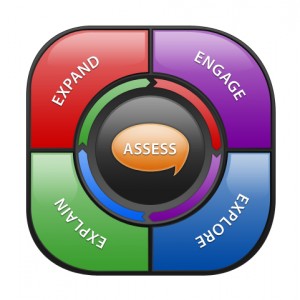Are you feeling overwhelmed by the amount of content in this issue? Or are you wondering how you can integrate these resources into your own classroom? We’ve created unit plans for Grades K-2 and 3-5 using the resources in this issue of Beyond Weather and the Water Cycle. The units are modeled after a learning cycle framework built around five key steps — Engage, Explore, Explain, Expand, and Assess (or Evaluate).

The Learning Cycle. Illustration from the Ohio Resource Center for Mathematics, Science, and Reading.
While these units can be implemented into your instruction as they are, they can also be modified to fit your particular teaching situation and students’ needs. We’d love to hear how you’ve made them fit into your classroom. Please post a comment and share!
GRADES K-2
This unit is designed to provide primary grades students the opportunity to investigate the Sun’s role in heating Earth’s land, air, and water. Students will use hands-on investigations and text to answer the unit question, How does sunlight affect temperature?
Standards Alignment
National Science Education Standards: Science Content Standards
Science content standards are found in Chapter 6 of the National Science Education Standards.
Science as Inquiry (Grades K-4)
- Ask questions about objects, organisms, and events in the environment
- Employ simple equipment and tools to gather data and extend the senses
- Use data to construct a reasonable explanation
- Communicate investigations and explanations
Physical Science (Grades K-4)
- Light, Heat, Electricity, and Magnetism
Earth and Space Science (Grades K-4)
- Objects in the Sky
IRA/NCTE Standards for the English Language Arts
View the standards at http://www.ncte.org/standards.
1 – Students read a wide range of print and nonprint texts.
3 – Students apply a wide range of strategies to comprehend, interpret, evaluate, and appreciate texts.
4 – Students adjust their use of spoken, written, and visual language (e.g., conventions, style, vocabulary) to communicate effectively with a variety of audiences and for different purposes.
5 – Students employ a wide range of strategies as they write and use different writing process elements appropriately to communicate with different audiences for a variety of purposes.
11 – Students participate as knowledgeable, reflective, creative, and critical members of a variety of literacy communities.
12 – Students use spoken, written, and visual language to accomplish their own purposes.
Engage
Provide students with a variety of pictures of the Sun – rising, setting, and in different seasons. Ask students to sort pictures by seasons. (Another option is to use our pre-made Seasons and the Sun sort on an interactive white board or at individual computers.) Discuss students’ rationale for their sorts, asking students to share what they know about the Sun in the process. Post student responses on chart paper.
Next, introduce the unit question, How does sunlight affect temperature? Guide students in making predictions, and record these on chart paper as well.
Explore
This phase of the unit uses the lessons The Warmth of the Sun and Cooler in the Shadows. In The Warmth of the Sun, students make qualitative observations of heat indoors and outdoors. In Cooler in the Shadows, students make inferences about the cause of shadows and explore properties such as heat and the brightness of light. Be sure to connect students’ experiences back to the unit question (How does sunlight affect temperature?) and provide sufficient time for students to share and discuss their findings. Conclude this phase of the unit by asking students to explain how their findings might answer the unit question.
Explain
Begin this phase of the unit by reading The Sun and the Seasons, our informational text written for students. We recommend the version for Grades K-2 (which has a Flesch-Kincaid reading level of 1.7). You might also read books from our virtual bookshelf. Be sure to allow plenty of time for discussion of each text, and help students make connections to the observations they made during the Explore phase. You might also have students practice making predictions with informational text, as described in the article Lessons about Making Predictions with Informational Text.
Next, ask students to write statements and draw pictures explaining what they learned from the hands-on experiences and texts, including an answer to the unit question. Students should be allowed (and encouraged!) to refer back to the materials used in the Explore phase and the texts read in the Explain phase. Student work might be compiled into a class book to be kept in the classroom for future reference.
Expand
This topic, sunlight and temperature, leads naturally into a study of the seasons. At the primary level, students should focus on making observations of seasonal change, such as the amount of daylight, temperatures, weather, and changes in plants, animals, and human behavior (dress and activities). The Polar Patterns: Day, Night, and Seasons issue of Beyond Penguins and Polar Bears includes lesson plans, a bookshelf, and unit plans for teaching these topics in the elementary grades.
Assess
Formative
Formative assessment can be conducted throughout the unit. For example:
- Students’ completion of the picture sort in the Engage phase will provide insight into their prior knowledge about the Sun and the seasons.
- Observation of students’ participation in Explore phase activities will provide insight into their current understanding and engagement with the topic.
- Student conversation during the Explore and Explain phases will demonstrate understanding, and may help you decide if certain concepts need to be addressed in more detail.
Summative
Students’ pictures or sentences about what they learned serve as summative assessment and provide evidence of their understanding of the Sun and sunlight’s effect on temperature. Student work can be assessed with a rubric that includes criteria for scientific accuracy, use of vocabulary, and overall quality of work.
GRADES 3-5
This unit is designed to provide upper elementary students the opportunity to investigate the Sun’s role in heating Earth’s land, air, and water and the concept of albedo.
Standards Alignment
National Science Education Standards: Science Content Standards
Science content standards are found in Chapter 6 of the National Science Education Standards.
Science as Inquiry (Grades K-4 and 5-8)
- Ask questions about objects, organisms, and events in the environment
- Employ simple equipment and tools to gather data and extend the senses
- Use data to construct a reasonable explanation
- Communicate investigations and explanations
Physical Science
- Light, Heat, Electricity, and Magnetism (Grades K-4)
- Transfer of Energy (Grades 5-8)
Earth and Space Science
- Objects in the sky (Grades K-4)
- Earth in the solar system (Grades 5-8)
IRA/NCTE Standards for the English Language Arts
View the standards at http://www.ncte.org/standards.
1 – Students read a wide range of print and nonprint texts.
3 – Students apply a wide range of strategies to comprehend, interpret, evaluate, and appreciate texts.
4 – Students adjust their use of spoken, written, and visual language (e.g., conventions, style, vocabulary) to communicate effectively with a variety of audiences and for different purposes.
5 – Students employ a wide range of strategies as they write and use different writing process elements appropriately to communicate with different audiences for a variety of purposes.
11 – Students participate as knowledgeable, reflective, creative, and critical members of a variety of literacy communities.
12 – Students use spoken, written, and visual language to accomplish their own purposes.
Engage
Use the NAEP assessment item: White clothes in hot weather to engage students in a real-world application of the scientific concepts. You might re-create the scenario described in the assessment item by placing black and white buckets full of water underneath a light source or out in the Sun and by having students monitor how the temperature changes in each bucket. Or, you might simply introduce the scenario and allow students to discuss it as a whole class or in small groups.
Explore
In this phase, students can investigate the absorption and reflection of light with the lessons Light Absorption and Atmospheric Processes — Radiation. In Light Absorption, students investigate how color affects absorption and temperature; in Atmospheric Processes — Radiation, they investigate a variety of different surfaces, including sand, potting soil, and water. Students might use science notebooks to record their findings.
Explain
Read “The Shiniest Moon,” an informational text written for students as part of the Beyond Penguins and Polar Bears magazine. You might also read books from our virtual bookshelf to connect students’ findings to solar energy. Be sure to allow plenty of time for discussion of each text, and help students make connections to the observations they made during the Explore phase. You might also have students practice making predictions with informational text, as described in the article Lessons about Making Predictions with Informational Text.
Next, return to the NAEP assessment item. If students wrote answers to the item during the Engage phase, ask them to revisit their answers and correct them using what they’ve learned in the unit. If students just discussed the item initially, have them answer the prompt in writing. Students should be allowed (and encouraged!) to refer back to the materials used in the Explore phase and the texts read in the Explain phase.
Expand
This topic, sunlight and temperature, leads naturally into a study of seasonal change in sunlight. Begin by reading The Sun and the Seasons, our informational text written for students. We recommend the version for Grades 3-5 (which has a Flesch-Kincaid reading level of 3.5), although the Grades K-2 version might be useful for students needing a simplified version of the text. You might also read books from our virtual bookshelf. Additionally, the Polar Patterns: Day, Night, and Seasons issue of Beyond Penguins and Polar Bears includes lesson plans, a bookshelf, and unit plans for teaching about seasonal change in the elementary grades.
Assess
Formative
Formative assessment can be conducted throughout the unit. For example:
- Student discussion in the Engage phase will provide insight into their prior knowledge about solar energy and the absorption and reflection of light.
- Observation of students’ participation in Explore phase activities will provide insight into their current understanding and engagement with the topic.
- Student conversation during the Explore and Explain phases will demonstrate understanding, and may help you decide if certain concepts need to be addressed in more detail.
Summative
Students’ written responses to the NAEP assessment item serve as summative assessment for the unit. Student work can be assessed with a rubric that includes criteria for scientific accuracy, use of vocabulary, and overall quality of work.
This article was written by Jessica Fries-Gaither. Jessica is an education resource specialist at The Ohio State University and project director of Beyond Penguins and Polar Bears. She has taught in elementary and middle school settings. Email Jessica at beyondweather@msteacher.org.
Copyright February 2011 – The Ohio State University. This material is based upon work supported by the National Science Foundation under Grant No. 1034922. Any opinions, findings, and conclusions or recommendations expressed in this material are those of the author(s) and do not necessarily reflect the views of the National Science Foundation. This work is licensed under an Attribution-ShareAlike 3.0 Unported Creative Commons license.



